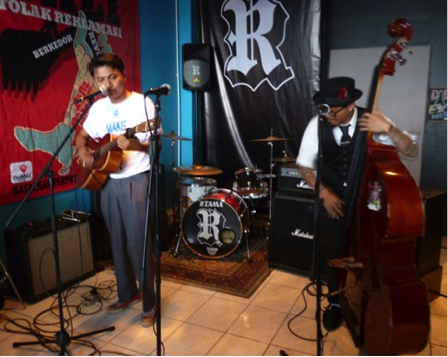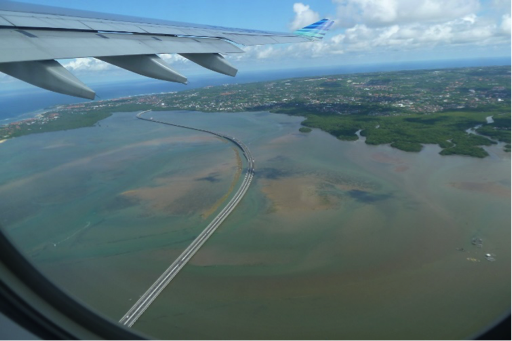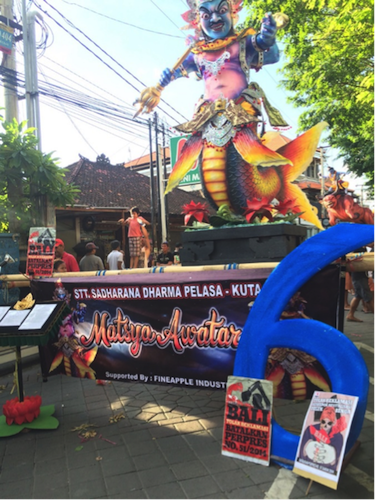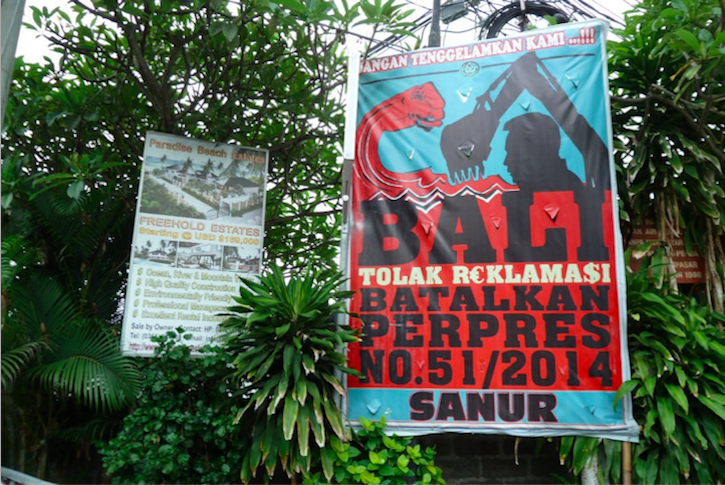Birgit Bräuchler
One Saturday night in March 2015 in downtown Denpasar a new store of the fashion label, Rumble, or RMBL, opened. Founded in 2010 and owned by Balinese rockabilly and punkrock musicians including Jerinx, the drummer of Superman is Dead (SID), the label allocates ten per cent of its profit to WALHI (Wahana Lingkungan Hidup Indonesia or The Indonesian Forum for Environment), Indonesia’s oldest and largest environmental NGO.
The Rumble opening was also a public and performative outlet for protest against an investor’s plan to reclaim land in Benoa Bay. For WALHI and supporters of the Tolak Reklamasi (reject reclamation) movement, such events are important means to express their resistance against land reclamation plans that they fear would threaten the island’s ecological balance and the livelihood of many fishers and farmers. At the venue, protest posters were put up, videos of other protest activities were screened, the movement song was sung. Prominent Balinese punkrock bands performed and the movement coordinator gave a heated speech. Music and protest entered a perfect fusion. One could not help but join in shouting ‘Tolak reklamasi!’

In the mid-1990s, environmental campaigns were strongly inflected by religious concerns. Now, RMBL’s support of WALHI as well as the movement’s strategic use of social media, music and visual art indicate an important change in protest culture on the island of Bali. It enables Balinese activists to increase their campaign’s visibility and their supporting base far beyond the local and the national level. Social media’s outreach and mobile technology allow for the mobilisation of movement followers worldwide.
Indeed, prominent cases such as the Arab Spring and the Occupy movement illustrate how media have become a crucial means for nonviolent protest. What Tolak Reklamasi has in common with protest movements in Egypt, Boston or Spain is their performative character. Although not strictly social media revolutions, the strategic combination of online networking and offline aggregation of substantive numbers of people makes them influential and infectious. It is the blending of parades, demonstrations, concerts, street art and ‘new’ and ‘old’ media that allow for the building of collective identities and make protest visible to a global public. It is this fusion of the languages of music, arts, law, environmentalism and global activism that shapes Bali’s new protest landscape.
Mass tourism and its discontents
Initial plans for Bali’s tourism industry in the early 1970s set out a model for the development of cultural tourism on the island and restricted tourism development to a handful of sites. In the late 1980s, this model was abandoned in favour of a deregulated model, allowing for massive investment in infrastructure and hotel construction all over the island. After a dramatic but short recession due to the Bali bombing in 2002, the tourism industry is now booming more than ever before. Although the Indonesian government is building on Bali’s cultural capital, its development policies are oriented towards increasing tourist numbers and infrastructure.
The first passionate and visible resistance against such aggressive policies arose in opposition to the planning of a resort near the seaside temple of Tanah Lot in 1993–94. The protests were mainly driven by students and a local newspaper, the Bali Post; their argument primarily revolved around the religious significance of the site.They failed, however, and the resort opened in 1997.
{gallery}Tolak reklamasi posters{/gallery}Twenty years later, another loud protest movement is targeting a huge project slated to reclaim around 700 hectares in Benoa Bay. The investor, PT Tirta Wahana Bali Internasional (TWBI) owned by Tomy Winata, one of Indonesia’s most successful businessmen, stresses that it will reclaim land in Benoa Bay for an environmentally friendly development that values Bali’s customs and culture and by preserving mangroves. Because of the emerging protest it renamed the project motto from reclamation to revitalisation – an alleged revitalisation of the ecosystem through the creation of multiple artificial islands in Benoa Bay.
The Benoa Bay protest is articulated very differently than twenty years ago. Now it is less campus-based activities and increasingly public and environmental NGOs organising and sustaining new forms of resistance. Global ecological and anti-capitalist issues, local empowerment and legal arguments are brought to the fore, religious sentiments come second – at least in the first phases of the movement. Through their extensive use of the web and social media, it involves a broader public that goes far beyond the intellectual circles of the Tanah Lot protests and becomes part of the global protest culture described above – a privilege that is granted only to places with high and mobile internet connectivity such as Bali. Culture has always been used as a form of resistance on Bali. In line with that tradition, culture and art are now being employed as weapons against outside intruders and as a means to criticise politics.
The main actor behind the protest movement and its media strategies is the Balinese Forum Against Reclamation or ForBali (Forum Rakyat Bali Tolak Reklamasi), founded mid-2013. It is an alliance of students, NGOs, musicians, artists, environmentally concerned citizens and several village representatives. As a member told me, they are fed up with the Balinese people’s passivity, enforced apoliticism and the government’s sales policy; they wanted to open a new chapter in the history of resistance on Bali. The forum’s coordinator, Gendo Suardana, is an outspoken Balinese lawyer and former head of WALHI Bali who calls himself Che Gendovara.This reflects how the movement is trying to stretch out globally by making use of transnationally known symbols of anti-imperialist struggles, such as Che Guevara.
A few benchmark data put the protests into perspective:
December 2011: A toll road is built across Benoa Bay as part of the central government's Master Plan for Acceleration of the Development of the Indonesian Economy (MP3EI), despite the bay’s status as conservation area (Presidential Decree No. 45/2011)
September 2012: TWBI asks Udayana University, Denpasar, to make a feasibility study and Environmental Impact Assessment (AMDAL) for land reclamation in Benoa Bay
December 2012: Not waiting for its results, the governor of Bali issues a permit paper that supports land reclamation at Benoa Bay (not made public)
June 2013: Football star Ronaldo is invited by TWBI to become mangrove ambassador for Bali
September 2013: Feasibility study says ‘No’ to reclamation
May 2014: Presidential decree turns conservation area (kawasan konservasi) of Benoa Bay into cultivation area (zona budidaya) of which a maximum of 700 hectares can be reclaimed (Presidential Decree No. 51/2014)

Goals and strategies
The movement’s main goal is to urge the Indonesian government to abrogate that decree. You will find these slogans in most of the mediated visuals of the movement: ‘Tolak Reklamasi Berkedok Revitalisasi Teluk Benoa’ (Reject Reclamation that is masked as Revitalisation of Benoa Bay) and ‘Batalkan Perpres No. 51 Tahun 2014’ (Revoke Presidential Decree No. 51/2014).
Media and art help to create an inclusive movement identity that goes beyond, but does not exclude specific identity markers such as religion. ForBali uses a variety of social media such as Twitter, Facebook, Instagram and YouTube, which brings the movement users worldwide who are either interested in the Bali case or issues of social injustice and environmental degradation more generally. It has t-shirts with the movement slogan that are sold or given to protesters on Bali and other spots worldwide where resistance against the reclamation plans are showcased. It has a movement song and Alit Ambara’s posters – a Balinese artist whose graphic design work is mostly dedicated to human rights activism. All is made available online and offline, via traditional and new/social media, thus giving these means for mobilisation a global reach.
The movement uses global platforms to write petitions such as the request to abrogate the Presidential Decree No. 51/2014 on change.org and they write official letters that are addressed locally to regional and national government institutions or the investor, but are also presented to a global public via social media. Images and reports of protest spread are staged in Bali as well as in Jakarta, Washington, Melbourne or Hamburg. Members meet in Taman Baca, a space for alternative literature, and they conquer and reclaim wider public space through processions, demonstrations or concerts, thus embodying and locally rooting protest that is articulated on an international scale at the same time. It is this combination of ‘old’ and ‘new’ media, but also of ‘tradition’ and ‘modernity’, which makes the movement compelling and enables it to motivate not only the tech-savvy youth, but also religious figures and representatives of traditional villages. The rising numbers of followers of ForBali’s tweets, for instance, and their offline activities, from a handful in 2013 to several thousands in 2016, are proof of that.

ForBali organises its own demonstrations, but also makes use of traditional or religious parades such as the Ogoh-Ogoh procession the night before the lunar new year to put up their banners. Balinese bands like Superman is Dead (SID), Navicula or Eco Defender lend their voices to the struggle. Jointly they put together an album, they organise concerts and sing the movement song: ‘Music is their weapon’, as the SID manager puts it.
There are also clear references to Balinese mythology and history in ForBali’s visual performances and in the reflections of some of its activists. Puputan, the spectacular mass suicide in the early twentieth century, for example, is variously mentioned as the strongest form of resistance. The current protest movement is seen as its continuation, directed against a new kind of colonialism through global capitalism and environmental destruction that is out to destroy Bali’s balanced relationship between humans, nature and god. The sacredness of places at Benoa Bay is emphasised thus rendering the reclamation of land an offence against the religiosity of the Hindu-Balinese and their ancestral role as caretakers of the island.
The Balinese population is divided with regards to the question whether to support or reject reclamation, but the Tolak Reklamasi movement is growing. The news about new comrades-in-struggle in Bali, Java, Australia, Europe and the US are posted, tweeted and spread via village council letters, posters and newspaper articles. But the other side does not sleep either and also makes extensive use of media. Opponents of Tolak Reklamasi knocked down billboards set up by the movement which gives expression to ForBali’s intimidation by the reclamation party. At the end of October 2015, a panel that was supposed to host ForBali activists was cancelled at the Ubud Writers and Readers Festival. In 2016 the police urged those participating in the Ogoh-Ogoh lunar new year procession carrying a Tolak Reklamasi poster or banner to put them down for the sake of public safety and order. The movement has been approaching Indonesia’s president by various means, still waiting for Jokowi to join their fight. The perseverance of the movement is a strong indication for major changes and successes in protest cultures more generally in Indonesia.
Birgit Bräuchler (birgit.braeuchler@monash.edu) is a researcher and senior lecturer in Anthropology, School of Social Sciences, Monash University.
